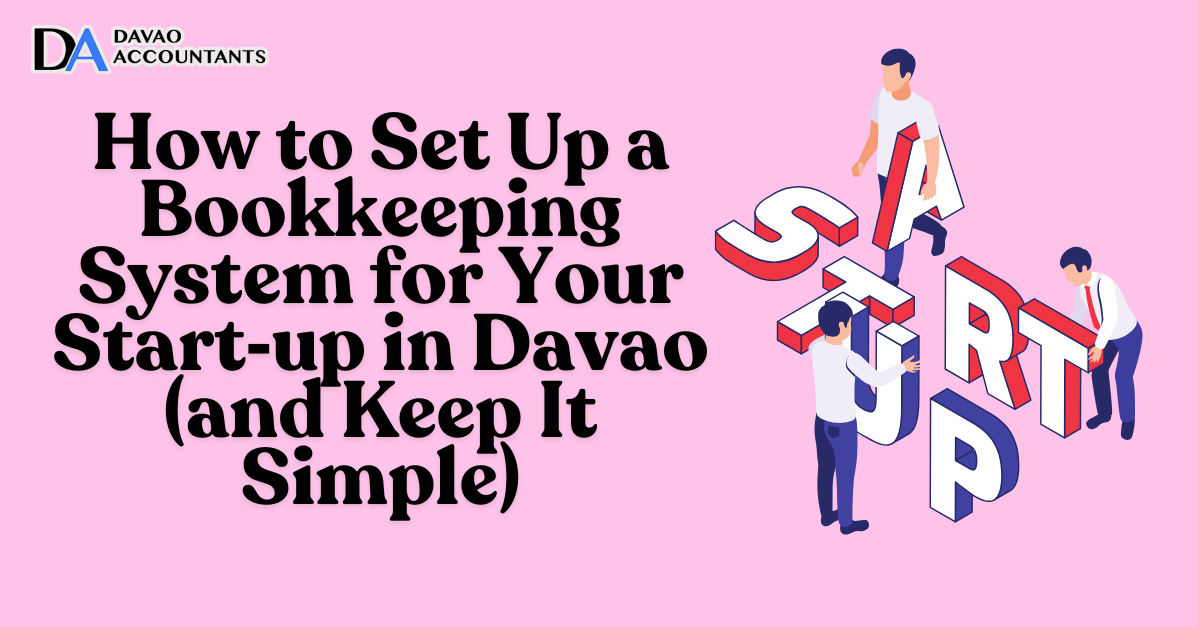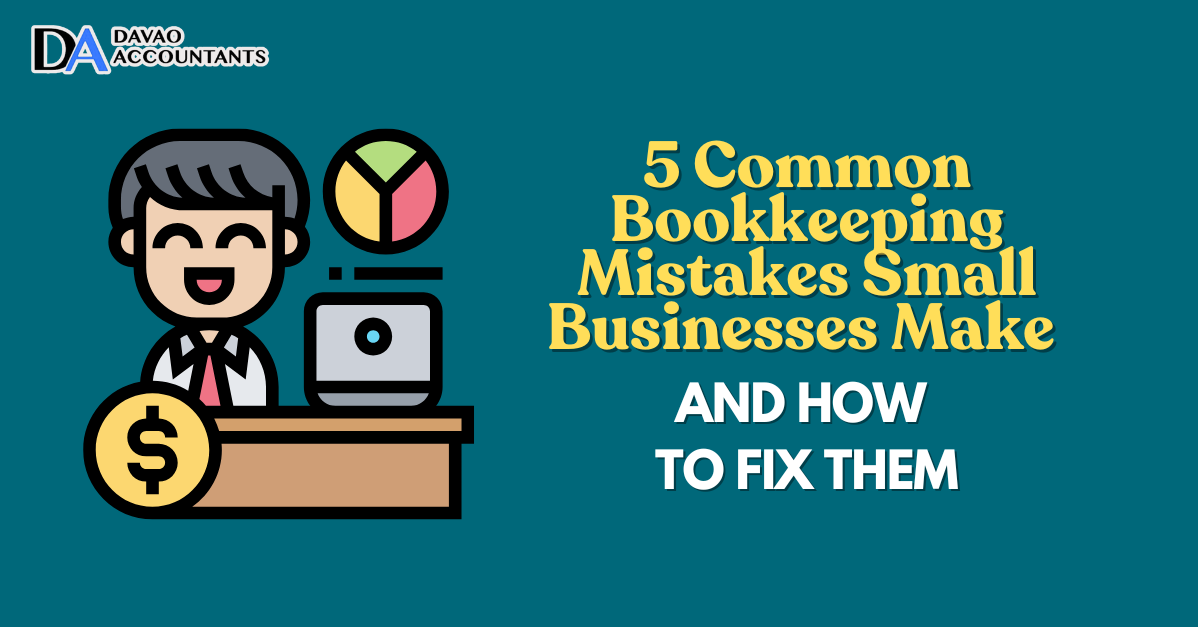Table of Contents
ToggleIntroduction
Launching a start‑up is exciting, with new ideas, growth potential, and fresh energy. But one of the most essential foundations for long‑term success is your bookkeeping system. Without clear records and organised transactions, what starts as a promising venture can become a compliance headache or a cash‑flow nightmare.
At Davao Accountants, we’ve helped many start‑ups and small businesses in Davao City and throughout Mindanao get their books in order from day one. In this article, we’ll walk you through how to set up a bookkeeping system that’s simple, scalable, and compliant—so you can focus on building your business, not sorting out a mess later.
Why a bookkeeping system matters for start‑ups
Even a start‑up needs to treat bookkeeping as a core part of operations. Here’s why:
- Financial clarity: You’ll know exactly how much money is coming in, how much is going out, and whether you’re profitable (or close to it).
- Cash flow management: Start‑ups often operate with constrained cash. Early bookkeeping helps you track payables and receivables and avoid surprises.
- Tax preparedness: Proper books help when you need to file with the Bureau of Internal Revenue (BIR) or respond to inquiries, whether it’s VAT, income tax, or percentage tax.
- Professionalism and credibility: Having organised financial records enhances your credibility with investors, banks, partners, and clients.
- Scalability: Setting up the right system from the start saves you from larger headaches when your business grows.
In short: a bookkeeping system is not optional—it’s an investment in your start‑up’s foundation.
Step 1: Understand your start‑up type and what you need
Before diving into the software and numbers, you need to clarify your business type. Ask these questions:
- Are you a sole proprietor, a partnership, or a corporation?
- Will you be VAT‑registered or non‑VAT (percentage tax) at the outset?
- What is your expected volume of transactions, clients, and expenses in the first year?
- How many bank accounts, payment channels, or revenue streams will you have?
- Do you have cash transactions, online sales, or a mix of income streams?
Understanding these will help you make the right decisions for your system, for example, selecting the appropriate Chart of Accounts, choosing software, and deciding whether to use manual or computerized bookkeeping. Clarity here saves time later.
Step 2: Choose your Chart of Accounts (CoA)
The Chart of Accounts (CoA) is your bookkeeping blueprint—it defines how you classify income, expenses, assets, liabilities, and equity. A well‑structured Chart of Accounts simplified for your start‑up does three things:
- Makes it easy to record transactions consistently.
- Helps you generate meaningful reports (income statements and balance sheets).
- Aligns your bookkeeping with tax and audit requirements in the Philippines.
How to set it up
- Start with major categories: Revenue (Sales), Cost of Goods Sold (if applicable), Operating Expenses, Assets, Liabilities, Owner’s/Shareholder Equity.
- Break down each into sub‑accounts. For example, under Operating Expenses, you might have: Marketing & Advertising, Rent, Utilities, Professional Fees, Travel, and Software Licenses.
- Under Assets, you might include: Cash & Bank Accounts, Accounts Receivable, Prepaid Expenses, Equipment, and Accumulated Depreciation.
- Liabilities might include: Accounts Payable, Loans Payable, and Withholding Taxes Payable.
- Equity: Owner’s Capital, Retained Earnings, etc.
Philippines‑specific tip
Even if you don’t anticipate being VAT‑registered right away, design your CoA so that you can scale into VAT-related accounts (e.g., Input VAT, Output VAT) if needed, rather than having to rework the setup later.
Step 3: Select your bookkeeping method and tools
Manual vs Computerised
For tiny start‑ups, you might start with a spreadsheet. But in today’s digital age, using bookkeeping or accounting software has clear advantages: speed, accuracy, reporting, integration with bank feeds, and an audit trail.
Software considerations for Philippine start‑ups
When selecting software in the Philippines, look for:
- Cloud or desktop? Cloud gives accessibility (work anywhere, anytime).
- BIR‑compliant features such as the Chart of Accounts templates and VAT/percentage tax modules.
- Bank feed or import function (so you don’t key everything manually).
- Ease of use—remember, you may not have a full‑time accountant initially.
- Good support and training resources.
According to one local review, top systems in the Philippines include QuickBooks Online, Xero, Sage 50, and local solutions. Starting with a cloud system enables you to scale as your business grows.
If the budget is tight
If you’re starting out, you could use an inexpensive system or even a structured spreadsheet template, then migrate as you grow. The key is to set up consistent routines from day one.
Step 4: Set up your bank/cash accounts and record‑keeping routines
Your bookkeeping system must link to the actual bank and cash flows. Here are key tasks:
- Open a business bank account (separate from personal finances).
- Create corresponding bank/cash accounts in your CoA.
- Set up a routine (e.g., weekly) to reconcile your bank statements with your books.
- Record receipts/invoices promptly—not months later.
- For online startups or e‑commerce, integrate payment gateways (PayPal, Stripe, GCash) and assign them correctly in your books.
Best practice
Schedule a “bookkeeping hour” each week where you review new income, expenses, reconcile bank feed/imports, and categorise items into your CoA. This keeps your system up‑to‑date and prevents backlog.
Step 5: Set up your invoices, receipts, and books of accounts
In the Philippines, bookkeeping is not just about recording—it’s also about compliance with the Bureau of Internal Revenue (BIR). For your start‑up, you must ensure:
- You issue official receipts (if providing services/goods) or invoices (if selling goods).
- You maintain and register your Books of Accounts (Manual, Loose‑leaf or Computerised) with the BIR.
- If you become VAT‑registered, you must have VAT invoices and track Output VAT and Input VAT.
What to do now
- Decide your receipt/invoice format and apply for Authority to Print (ATP) if required.
- Create your books of accounts: General Ledger, General Journal, Cash Receipts Book, Cash Disbursements Book, etc.
- When using software, ensure journals are automatically generated or supported.
- Keep copies of receipts, invoices, and supporting documentation (digital or physical) for audit support.
Step 6: Establish your reporting rhythm
A bookkeeping system isn’t useful unless you regularly review what it produces. For a start‑up, establish the following rhythm:
- Monthly: Close your books for the month. Review income, expenses, and bank reconciliations. Produce an income statement (profit & loss) and balance sheet.
- Quarterly: Review strategy, check whether your revenue thresholds are changing (e.g., approaching VAT threshold). Prepare quarterly reports.
- Annually: Prepare or review full-year financials, meet with your accountant for year‑end tasks and tax planning.
Why is this important
Running your reports monthly gives you visibility into performance and helps you adjust quickly. Quarterly and annual reviews help you plan, budget, and ensure you stay compliant with tax and regulatory requirements.
Step 7: Stay compliant & prepare for growth
Being compliant from the start avoids headaches. Key compliance items:
- If your start‑up crosses the VAT registration threshold (currently ₱3 million gross receipts), you’ll need to register for VAT.
- Keep your Books of Accounts properly maintained and submitted where required.
- Keep your receipts/invoices and documentation for at least five years (in case of BIR audit).
- Make your bookkeeping system scalable so that when you hire staff, expand operations, or open new branches, you are ready.
Growth readiness
Rather than overhaul your system when growth comes, design your bookkeeping structure now with expansion in mind. This means:
- Use software that can handle multi‑entity or multiple locations.
- Structure your CoA so that future cost centres can be added.
- Use banking/ payment feeds and automation to reduce manual work.
Common Mistakes Start‑ups Make (and how you avoid them)
Here are typical errors and corresponding preventive steps:
- Mistake: Using a personal bank account for business. Fix: Open and use a separate business account from day one.
- Mistake: Delaying entry of transactions until the month‑end. Fix: Enter income/expenses weekly or sooner.
- Mistake: Using too many generic expense categories. Fix: Use detailed sub‑accounts in CoA for clarity and reporting.
- Mistake: No reconciliation of bank/cash accounts. Fix: Schedule monthly reconciliations and address discrepancies promptly.
- Mistake: Choosing a cheap/spreadsheet setup and never upgrading when needed. Fix: Start simple, but choose a scalable software and migrate when ready.
Real‑life checklist for Davao start‑ups
Here’s a checklist you can use for your start‑up in Davao:
☐ Open a business bank account
☐ Create Chart of Accounts
☐ Choose and set up accounting software (or template)
☐ Set up Books of Accounts per BIR requirements
☐ Issue receipts/invoices and apply for ATP if needed
☐ Establish a weekly bookkeeping routine
☐ Reconcile bank/cash monthly
☐ Produce monthly income statement and balance sheet
☐ Review quarterly for growth indicators (e.g., VAT threshold)
☐ Store digital/physical supporting documents safely
☐ Plan for future scalability (software, cost centres, additional accounts)
Conclusion
Setting up an effective bookkeeping system might not feel glamorous in the early days of your start‑up, but it is one of the most powerful assets you will build. A system built with clarity, consistency, and compliance in mind gives you:
- Better financial insights to make decisions
- Fewer surprises when tax time or an audit comes around
- Confidence to scale your operations effectively
- Peace of mind because you know your books are in order
At Davao Accountants, we’re here to help you set up your bookkeeping system, tailor it for your start‑up’s specific needs in Davao, and make sure it grows with you. Reach out for a consultation, and let’s build a foundation for your business that’s structured, efficient, and resilient.











